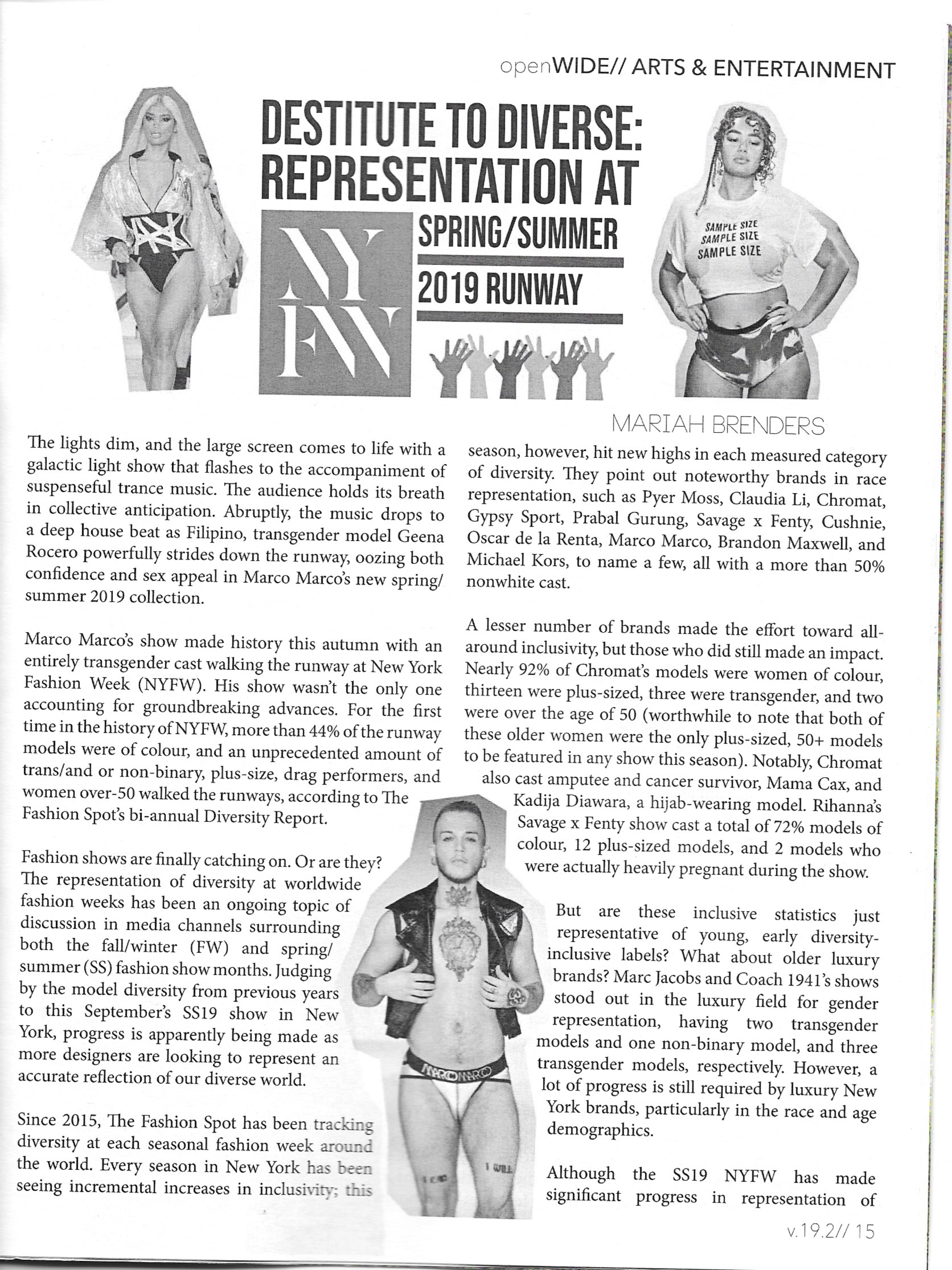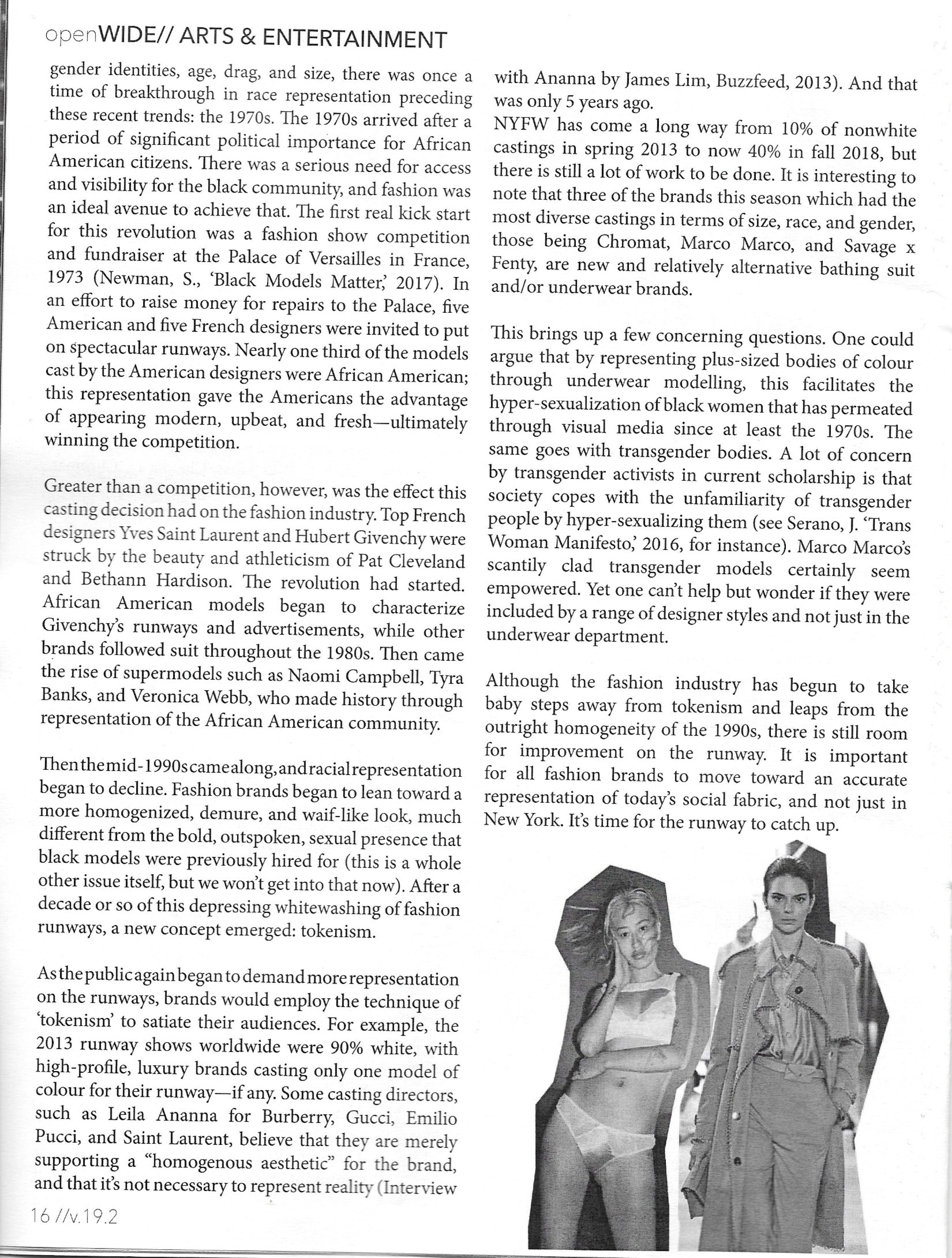Destitute to Diverse: Representation at NYFW’s Spring/Summer 2019 Runway
From October 2018
Originally published in OPENWIDE print volume 19, issue 2: openwidezine.com
A Chromat Spring/Summer 2019 runway look. Photo credit: Chromat.
The lights dim, and the large screen comes to life with a galactic light show that flashes to the accompaniment of suspenseful trance music. The audience holds its breath in collective anticipation. Abruptly, the music drops to a deep house beat as Filipino, transgender model Geena Rocero powerfully strides down the runway, oozing both confidence and sex appeal in Marco Marco’s new spring/summer 2019 collection.
Marco Marco’s show made history this autumn with an entirely transgender cast walking the runway at New York Fashion Week (NYFW). His show wasn’t the only one accounting for groundbreaking advances. For the first time in the history of NYFW, more than 44% of the runway models were of colour, and an unprecedented amount of trans/and or non-binary, plus-size, drag performers, and women over-50 walked the runways, according to The Fashion Spot’s biannual Diversity Report.
Fashion shows are finally catching on. Or are they? The representation of diversity at worldwide fashion weeks has been an ongoing topic of discussion in media channels surrounding both the fall/winter (FW) and spring/summer (SS) fashion show months. Judging by the model diversity from previous years to this September’s SS19 show in New York, progress is apparently being made as more designers are looking to represent an accurate reflection of our diverse world.
Since 2015, The Fashion Spot has been tracking diversity at each seasonal fashion week around the world. Every season in New York has been seeing incremental increases in inclusivity; this season, however, hit new highs in each measured category of diversity. They point out noteworthy brands in race representation, such as Pyer Moss, Claudia Li, Chromat, Gypsy Sport, Prabal Gurung, Savage x Fenty, Cushnie, Oscar de la Renta, Marco Marco, Brandon Maxwell, and Michael Kors, to name a few, all with a more than 50% nonwhite cast.
A lesser number of brands made the effort toward all-around inclusivity, but those who did still made an impact. Nearly 92% of Chromat’s models were women of colour, thirteen were plus-sized, three were transgender, and two were over the age of 50 (worthwhile to note that both of these older women were the only plus-sized, 50+ models to be featured in any show this season). Notably, Chromat also cast amputee and cancer survivor, Mama Cax, and Kadija Diawara, a hijab-wearing model. Rihanna’s Savage x Fenty show cast a total of 72% models of colour, 12 plus-sized models, and 2 models who were actually heavily pregnant during the show.
But are these inclusive statistics just representative of young, early diversity-inclusive labels? What about older luxury brands? Marc Jacobs and Coach 1941’s shows stood out in the luxury field for gender representation, having two transgender models and one non-binary model, and three transgender models, respectively. However, a lot of progress is still required by luxury New York brands, particularly in the race and age demographics.
Although the SS19 NYFW has made significant progress in representation of gender identities, age, drag, and size, there was once a time of breakthrough in race representation preceding these recent trends: the 1970s.
The 1970s arrived after a period of significant political importance for African American citizens. There was a serious need for access and visibility for the black community, and fashion was an ideal avenue to achieve that. The first real kickstart for this revolution was a fashion show competition and fundraiser at the Palace of Versailles in France, 1973 (Newman, S., ‘Black Models Matter,’ 2017). In an effort to raise money for repairs to the Palace, five American and five French designers were invited to put on spectacular runways. Nearly one third of the models cast by the American designers were African American; this representation gave the Americans the advantage of appearing modern, upbeat, and fresh—ultimately winning the competition.
Greater than a competition, however, was the effect this casting decision had on the fashion industry. Top French designers Yves Saint Laurent and Hubert Givenchy were struck by the beauty and athleticism of Pat Cleveland and Bethann Hardison. The revolution had started. African American models began to characterize Givenchy’s runways and advertisements, while other brands followed suit throughout the 1980s. Then came the rise of supermodels such as Naomi Campbell, Tyra Banks, and Veronica Webb, who made history through representation of the African American community.
Then the mid-1990s came along, and racial representation began to decline. Fashion brands began to lean toward a more homogenized, demure, and waif-like look, much different from the bold, outspoken, sexual presence that black models were previously hired for (this is a whole other issue itself, but we won’t get into that now). After a decade or so of this depressing whitewashing of fashion runways, a new concept emerged: tokenism.
As the public again began to demand more representation on the runways, brands would employ the technique of ‘tokenism’ to satiate their audiences. For example, the 2013 runway shows worldwide were 90% white, with high-profile, luxury brands casting only one model of colour for their runway—if any. Some casting directors, such as Leila Ananna for Burberry, Gucci, Emilio Pucci, and Saint Laurent, believe that they are merely supporting a “homogenous aesthetic” for the brand, and that it’s not necessary to represent reality (Interview with Ananna by James Lim, Buzzfeed, 2013). And that was only 5 years ago.
NYFW has come a long way from 10% of nonwhite castings in spring 2013 to 40% now in fall 2018, but there is still a lot of work to be done. It is interesting to note that three of this season’s brands which had the most diverse castings in terms of size, race, and gender, those being Chromat, Marco Marco, and Savage x Fenty, are new and relatively alternative bathing suit and/or underwear brands.
This brings up a few concerning questions. One could argue that by representing plus-sized bodies of colour through underwear modelling, this facilitates the hyper-sexualization of black women that has permeated through visual media since at least the 1970s. The same goes with transgender bodies. A lot of concern by transgender activists in current scholarship is that society copes with the unfamiliarity of transgender people by hyper-sexualizing them (see Serano, J. ‘Trans Woman Manifesto,’ 2016, for instance). Marco Marco’s scantily clad transgender models certainly seem empowered, but one can’t help but wonder if they were included by a range of designer brands—and not just in the underwear department—that they could really make an impact on representation in the fashion industry.
Although the fashion industry has begun to take baby steps away from tokenism and leaps from the outright homogeneity of the 1990s, a great deal of improvement is still left for the runway. It is important for all fashion brands to move toward an accurate representation of today’s social fabric, and not just in New York. It’s time for the runway to catch up.


